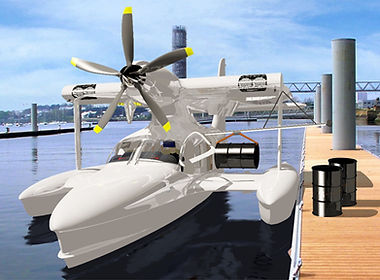
The breakthrough
Ocean’s new hull form typically reduces hydrodynamic drag on take-off by 40%, allowing increased max weight and useful load. With lower drag in cruise reducing energy requirements and both flaps in propeller-slipstream and stub-wings in ground-effect augmenting lift, these cumulate to offer step-change useful-load, payload-range and work-efficiency advantages.
The benefits make the Ocean seaplanes exceptionally suited to carbon-neutral power systems and accommodating of both their weight and cost penalties.
New capability
Ocean seaplanes are bringing step-change improvements with respect to the major purchase-decision and operating opportunity factors. These will wholly disrupt and expand out seaplane markets.
1. Range with payload doubled
Ocean’s revolutionary hull form, meeting no 'drag hump' on acceleration, typically reduces hydrodynamic drag on take-off by 40%, allowing major increases in max weight and useful load for given power. Lower drag in cruise reduces energy requirements. Flaps in propeller-slipstream and stub-wings in ground-effect augment lift. These cumulate to offer a step-change increase in useful-load. Used for fuel or other energy storage, aided by cruise efficiency advantages, this doubles range with payload n relation to conventionally conceived seaplanes.
The same benefits make the Ocean seaplanes exceptionally suited to carbon-neutral power systems in accommodating any of both weight and cost penalties.
2. Wave-height capability doubled

The new Ocean hull penetrates waves, damps pitching and minimises shock-loads. Tolerance to twice a high short steep waves as conventional hull concepts allows reliable new operations in common open-water conditions and services on weather-sensitive coastlines.
3. Access points increased five-fold


With wings folded, Ocean seaplanes can taxi silently using an electric water thruster, for berthing or docking anywhere that similar sized vessels can go. This increases accessible coastal facilities five-fold, otherwise prevented by fixed wingspans. It allows the Ocean seaplanes into every marina, harbour and dock to multiply high-value route options. It opens diverse options for resupply, engineering and shelter. It evades costly landing fees and airport use and takes secondary surface transports out of the equation.
Unaffected by saltwater, the Ocean composite structures extend airframe lives to forty years from five to ten years for seaplanes operated in salt water. With reduced maintenance costs and down-time, higher natural utilisation and both load-capacity and work-efficiency advantages, the Ocean seaplanes slash the critical life-cycled cost per seat-mile and thus break-even charge rates. Tropical salt-water operations will reduce these costs by typically 50%.

5. Safety levels heightened
6. Night and IMC operations enabled
New onboard sensing, guidance and display technologies combined with new water-based lighting technologies will enable safe commercial water operations at night. This has far reaching implications in increasing the usage, competitiveness with landplanes, revenue capability and value in Ocean seaplane ownership and operation.